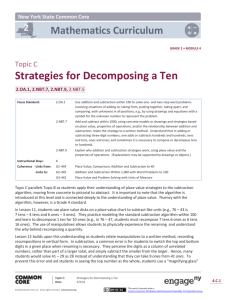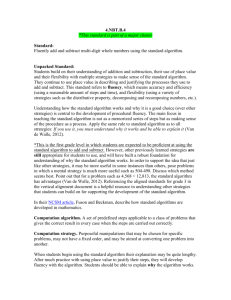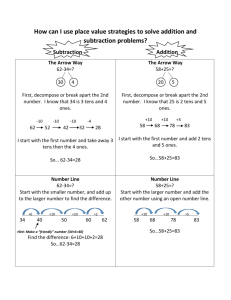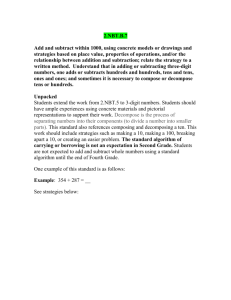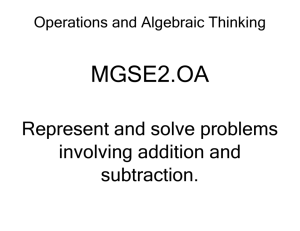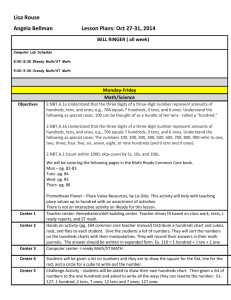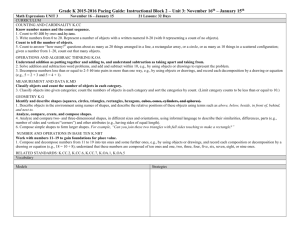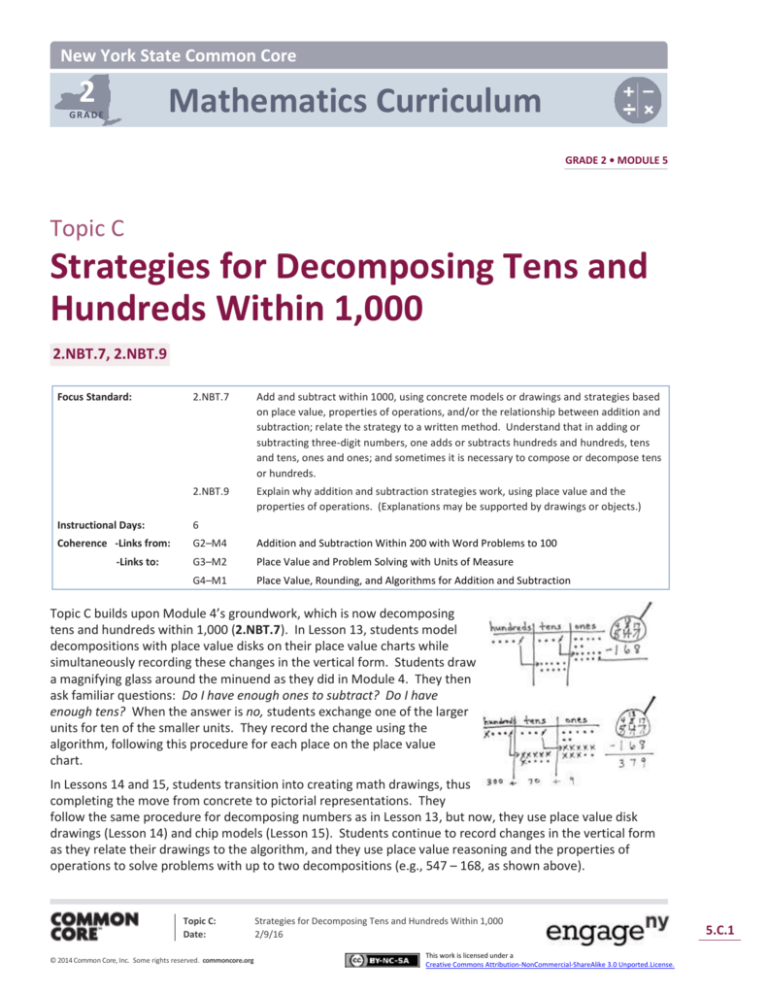
New York State Common Core
2
Mathematics Curriculum
GRADE
GRADE 2 • MODULE 5
Topic C
Strategies for Decomposing Tens and
Hundreds Within 1,000
2.NBT.7, 2.NBT.9
Focus Standard:
2.NBT.7
Add and subtract within 1000, using concrete models or drawings and strategies based
on place value, properties of operations, and/or the relationship between addition and
subtraction; relate the strategy to a written method. Understand that in adding or
subtracting three-digit numbers, one adds or subtracts hundreds and hundreds, tens
and tens, ones and ones; and sometimes it is necessary to compose or decompose tens
or hundreds.
2.NBT.9
Explain why addition and subtraction strategies work, using place value and the
properties of operations. (Explanations may be supported by drawings or objects.)
Instructional Days:
6
Coherence -Links from:
G2–M4
Addition and Subtraction Within 200 with Word Problems to 100
G3–M2
Place Value and Problem Solving with Units of Measure
G4–M1
Place Value, Rounding, and Algorithms for Addition and Subtraction
-Links to:
Topic C builds upon Module 4’s groundwork, which is now decomposing
tens and hundreds within 1,000 (2.NBT.7). In Lesson 13, students model
decompositions with place value disks on their place value charts while
simultaneously recording these changes in the vertical form. Students draw
a magnifying glass around the minuend as they did in Module 4. They then
ask familiar questions: Do I have enough ones to subtract? Do I have
enough tens? When the answer is no, students exchange one of the larger
units for ten of the smaller units. They record the change using the
algorithm, following this procedure for each place on the place value
chart.
In Lessons 14 and 15, students transition into creating math drawings, thus
completing the move from concrete to pictorial representations. They
follow the same procedure for decomposing numbers as in Lesson 13, but now, they use place value disk
drawings (Lesson 14) and chip models (Lesson 15). Students continue to record changes in the vertical form
as they relate their drawings to the algorithm, and they use place value reasoning and the properties of
operations to solve problems with up to two decompositions (e.g., 547 – 168, as shown above).
Topic C:
Date:
© 2014 Common Core, Inc. Some rights reserved. commoncore.org
Strategies for Decomposing Tens and Hundreds Within 1,000
2/9/16
This work is licensed under a
Creative Commons Attribution-NonCommercial-ShareAlike 3.0 Unported.License.
5.C.1
Topic C 2
NYS COMMON CORE MATHEMATICS CURRICULUM
Lessons 16 and 17 focus on the special case of subtracting from multiples of 100 and numbers with zero in the
tens place. Students recall the decomposition of 100 and 200 in Module 4 in one or two steps, using the
same reasoning to subtract from larger numbers. For example, 300 can be decomposed into 2 hundreds and
10 tens, and then 1 ten is decomposed into 10 ones (two steps). Additionally, 300 can be renamed directly as
2 hundreds, 9 tens, and 10 ones (one step). In each case, students use math drawings to model the
decompositions and relate them to the vertical form, step-by-step.
In Lesson 18, students work with three-digit subtraction problems, applying multiple strategies to solve. For
example, with 300 – 247, students learn that they can use compensation to subtract 1 from each number,
making the equivalent expression 299 – 246, which requires no renaming. Note that compensation is
formally named in Module 5, although the concept was introduced in Module 4. Students may also use the
related addition sentence, 247 + ___ = 300. The arrow notation is then used to solve, counting up 3 to 250,
and then adding on 50, to find the answer of 53. For some problems, such as 507 – 359, students may choose
to draw a chip model and relate it to the algorithm, renaming 507 as 4 hundreds, 9 tens, 17 ones in one step.
As students apply alternate methods, the emphasis is placed on students explaining and critiquing various
strategies.
A Teaching Sequence Toward Mastery of Strategies for Decomposing Tens and Hundreds Within 1,000
Objective 1: Relate manipulative representations to the subtraction algorithm, and use addition to
explain why the subtraction method works.
(Lesson 13)
Objective 2: Use math drawings to represent subtraction with up to two decompositions, relate
drawings to the algorithm, and use addition to explain why the subtraction method works.
(Lessons 14–15)
Objective 3: Subtract from multiples of 100 and from numbers with zero in the tens place.
(Lessons 16–17)
Objective 4: Apply and explain alternate methods for subtracting from multiples of 100 and from
numbers with zero in the tens place.
(Lesson 18)
Topic C:
Date:
© 2014 Common Core, Inc. Some rights reserved. commoncore.org
Strategies for Decomposing Tens and Hundreds Within 1,000
2/9/16
This work is licensed under a
Creative Commons Attribution-NonCommercial-ShareAlike 3.0 Unported.License.
5.C.2


